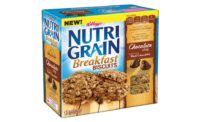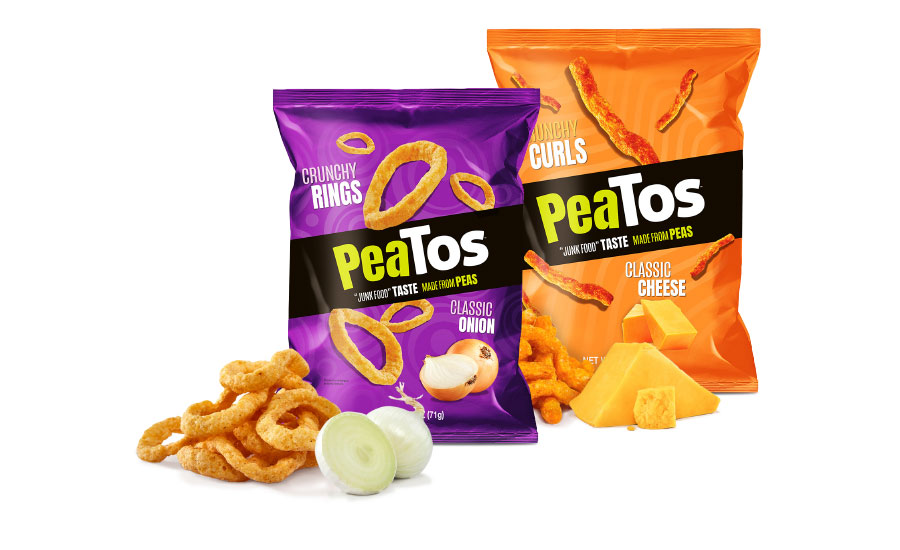PeaTos brings better-for-you differentiation to classic snack formats






Nick Desai is on a mission to change the way we snack.
Desai is the founder and CEO of World Peas Brand PeaTos, a division of Snack it Forward, Los Angeles. When PeaTos cheese snacks hit the market in 2017, they immediately made waves. Now, three short years later, PeaTos are distributed from coast to coast, and its ardent fan base continues to see rapid growth.
The roots of success
Desai previously worked as a lawyer in the entertainment business, and then shifted over to the investment world, where he helped smaller companies raise capital, and complete mergers and acquisitions. He had always aspired to stride out on his own. “In 2008, when the markets shifted, I pursued my dream to run my own company. I really liked the concept of helping fix something and turning something around.”
In 2008, due to the financial crisis, a lot of companies were in distress, and Desai started getting involved with small turnaround efforts, helping software and technology companies get back on their feet. “Then, in 2011, I came across a snack food company that was doing nuts and trail mix products, and it was in need of a turnaround.”
That work rekindled an idea that had lingered in the back of Desai’s mind. “I had this notion of disrupting the snack market in the U.S. As a child, I was an avid consumer of salty, crunchy snacks—Frito-Lay products like Cheetos, Funyuns, Doritos, and Fritos. I always marveled at how good they were.”
Desai was born in the U.S., but his parents were from India. “I would travel to India a lot as a child to visit my grandparents. And when I went to India, I was exposed to the Indian world of salty, fried, crunchy snacks—and I loved them.” While there were some strong similarities between American and Indian snacks, they had distinct differences, as well—primarily the substrate of choice, which in India was typically peas or lentils instead of corn, the historically favored snack base in the U.S.
Extruded cheese snacks are typically about 65 percent corn, 25 percent oil, and about 10 percent seasoning, notes Desai. But consumers don’t buy cheese snacks because of the corn or oil. It’s the flavor that they’re after. “So that 90 percent of the snack is just a carrier for the seasoning.”
In India, they weren’t using peas and lentils in snacks because they were trying to make them healthier, says Desai, they were just locally available, just like corn in the U.S. But in recent years the U.S. snack market has started making use of more better-for-you ingredients like peas and lentils—particularly in puffed and extruded snacks.
This resulted in a “eureka” moment for Desai. “I was noticing that a lot of companies were using different ingredients to create alternatives to traditional ‘junk food’ snacks, ‘clean label’ versions of corn-based snacks.” And they were using ingredients like peas and lentils, which have higher levels of fiber and protein than corn.
“My first thought was to import Indian snacks and market them here in the U.S.,” says Desai. But through his experiences in revitalizing struggling companies, he learned a lot of hard lessons. “One of the biggest ones was how hard it is to change consumer behavior patterns. To help consumers understand something new and different takes a long time and a lot of money.”
A snack is born
As part of the revitalization of the nut and trail mix company Desai had purchased in 2011, he created a marketing strategy to merchandise the snacks in the produce section of the store at major retailers like Kroger, H-E-B, and Walmart. “We really got to know the produce section,” he says.
“One of my early investors in the nut and trail mix company that we acquired was Carlos Barroso, the former head of global R&D for Frito-Lay,” says Desai. As a result of this relationship, the team started to learn more about the anatomy of snack foods. The pieces of the puzzle were coming together.
“Then, one day, one of our team members walked into my office and he put what looked like a Cheeto on my desk,” says Desai. “So I said, ‘Hey, great, I love Cheetos, too.’ And he said, ‘That’s not a Cheeto. It’s made from peas, not corn.’” It was a moment of revelation.
“It wasn’t anywhere close to where we needed it to be at that point, but it provided an inspiration for what came next,” says Desai. “We ended up spending about a year and a half, starting in about 2016, working on the concept. Our job was basically to make a pea-based Cheeto look, act, talk, and walk as close to a corn-based Cheeto as possible, because that’s what America is used to.”
The work culminated in the PeaTos brand launch toward the end of 2017. “At first, the ‘PeaTos’ name was kind of a joke,” says Desai. It was the working title for the project, but the name stuck.
The similarity to the Cheetos name is no accident. “We decided that if we’re going to try to disrupt this category, we can’t tiptoe around the fact that Frito-Lay dominates snacks,” says Desai.
One clear point of differentiation was the strategy of marketing PeaTos in the produce section. “It’s like going after the 800-pound gorilla in the room from the flanks instead of trying to advance head-on in its own turf,” says Desai.
PeaTos Crunchy Curls initially launched in Classic Cheese flavor and later expanded to include Fiery Hot and Zesty Ranch.
“We’re taking America’s favorite snacks and replacing the underlying corn base with a pea base, and we’re going to keep innovating until they’re almost indistinguishable from the leading brands,” says Desai. “We want a mom to be able to put PeaTos in front of her five-year-old child who loves Cheetos without them knowing the difference. And it’s already happening. We’re getting great feedback from moms. And kids are amazing, because they’re super honest with their feelings, and they often don’t have a built-in preconceived notion on what a corn-based snack should taste like. Taste buds aren’t fixed—they’re not carved in stone. They evolve and change based on what we consume. America’s palate is used to corn. But it doesn’t have to be that way. And a great starting point is with kids.”
Building awareness
As a young, growing brand, PeaTos doesn’t have a marketing budget that lends itself to Super Bowl television ads. “We’ve learned that we need to be scrappy in terms of building brand awareness,” says Desai. “Our brand ethos is centered on flavor and fun. A lot of these ‘better-for-you’ brands get very serious.” PeaTos is bringing the fun into better-for-you. “We’re using a lot of comedy and parody as methods to gain attention. We’re using digital marketing, social media marketing. It’s more of a level playing field, where both younger brands and more-mature brands with more money can access people in the same way. The internet has made marketing a lot more democratic.”
PeaTos also engages prospective customers through sampling. “Sampling is a core part of our ethos,” says Desai. “There’s a huge surprise factor when people try our product. We have a dedicated program to get products out to influencers.”
When SF&WB spoke with Desai in February, he noted that PeaTos had sent out around $40,000 worth of samples in January alone.
“The other thing that we’re doing is going into alternate markets,” says Desai. “Alaska Airlines is a great example. They had the snack on their airline late last year. Alaska gave out 750,000 bags of PeaTos in a span of three months. We’ve also had a lot of success with some corporate foodservice customers. Large technology companies are offering a range of perks, including snacks. Snacking is a form of stress release.” And PeaTos fits into prevailing trends related to health and wellness, as well as sustainability, primarily due to the agricultural merits of peas as a crop, including its better water efficiency and reduced reliance on fertilizers compared to corn. “Companies love that message,” he says.
The brand had a strong national launch, and it’s starting to catch on in multiple markets. “Our first customer out the gate was Kroger,” says Desai. “We launched overnight in 2,000 stores nationwide. And we found that the sales by region haven’t varied that much, which is super exciting to us. It’s broad appeal, catering to the 90 percent of America that isn’t the ‘core natural channel consumer.’ We’re trying to get 90 percent of America to eat 10 percent better rather than 10 percent of America to eat 90 percent better. That’s our philosophy.”
Snacking it forward
After mastering its take on Cheetos, the PeaTos team set its sights on Funyuns—another wildly popular corn-based snack. “We’re not trying to reinvent the wheel,” says Desai. “We took a look at our supply chain, which was already built for an extruded-style snack platform, and identified another super-successful extruded snack, Funyuns. Boom. A nice ring made out of peas instead of corn. It’s supposed to deliver an onion flavor anyway. Nobody buys Funyuns for the corn. So we developed PeaTos Rings. And they’ve been incredible. Three weeks after launch, they were one of the top-selling snacks in the produce section at Kroger.” PeaTos Rings come in Classic Onion and Fiery Onion flavors.
PeaTos has a core group of product developers working on its extruded snacks platform. “At the end of the day, while the differences between the Curls and Rings might seem large, from a product development perspective, they’re very similar.” The company is using the same contract manufacturer for both products. “Our core team is comprised of experts in pulse-based applications, seasoning and other areas of snack development. I’m really proud of our team members and the tenacity and grit that they’ve shown.”
PeaTos already has other snacks in the works. “We’re working on other items, but I can’t talk too much about that right now,” says Desai. “But if you look at the clues, you can probably figure out what might be coming next.”
AT A GLANCE
Company: Snack it Forward, World Peas Brand PeaTos
Headquarters: Los Angeles
Website: https://peatos.com
Products: Cheese curls, onion rings
Brand: PeaTos
Founder and CEO: Nick Desai
Looking for a reprint of this article?
From high-res PDFs to custom plaques, order your copy today!










